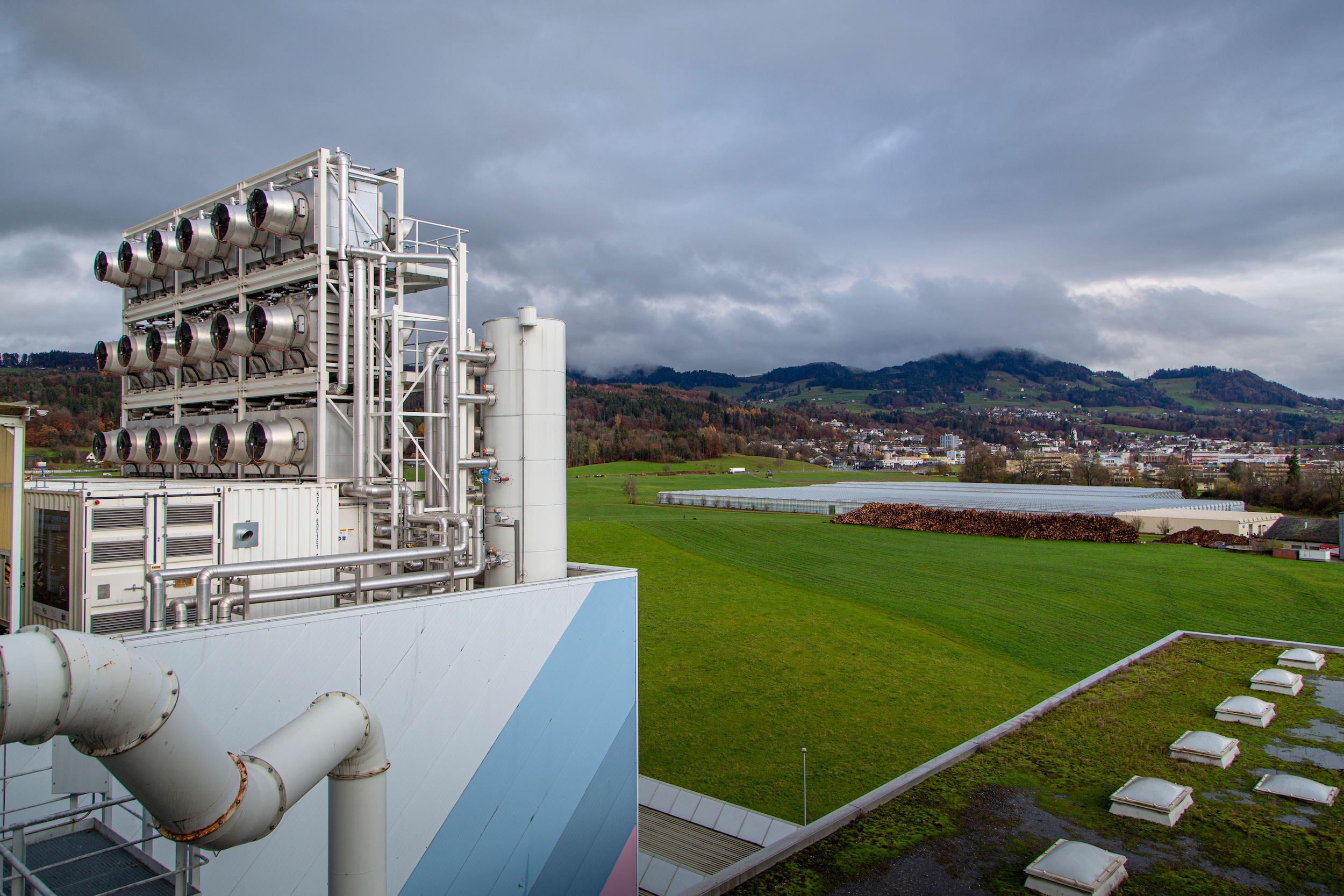A nascent industry removing carbon from the atmosphere and storing it in trees, rocks and the ocean will need to quadruple in size by 2050 if the world is to keep temperature rise to within the internationally agreed threshold of 1.5C, a new report has found.
“Carbon dioxide removal” is defined by the UN’s climate science body, the IPCC (Intergovernmental Panel on Climate Change), as human activity that captures CO2 from the atmosphere and stores it for decades to millennia in geological, land or ocean reservoirs, or in products.
Around two billion tonnes of carbon are currently removed in this way each year, mostly using conventional methods such as afforestation and reforestation, wetland restoration and soil improvement.
However, an industry in more novel techniques has seen rapid growth in recent years. Such methods include: storing carbon in products like construction materials or “biochar”, a carbon-rich material produced by heating biomass in an oxygen-limited environment; enhanced rock weathering, which involves spreading finely ground silicate rock onto surfaces to speed up chemical reactions between rocks, water, and air; and direct air carbon capture and storage (DACCS), where carbon is separated from the air using chemical processes and deposited underground.
Last month, the world’s largest commercial DACCS plant, dubbed Mammoth, began operating in Iceland. It will draw down 36,000 tonnes of CO2 from the air every year and store it permanently underground, says the company behind it, Climeworks. The company is planning to build “multiple megaton hubs” in the US, meaning several facilities that can remove a million or more tonnes of CO2 per year.
Today such novel methods remove just 1.3 million tonnes of carbon a year, less than 0.1% of total carbon removals, with conventional methods responsible for the remaining 99.9%, the analysis found. But the researchers behind the report are optimistic that both novel and conventional methods can be scaled up to reach the estimated required level of 7-9 billion tonnes of CO2 per year by 2050.
Taken together, the carbon removal capacity proposed by companies globally would be sufficient to reach this, the authors found. However, they did not assess the likelihood of individual plans or announcements coming to fruition.
Diverse methods
The report, which was led by academics at the University of Oxford’s Smith School of Enterprise and the Environment, but also involved more than 50 international experts, stresses that politicians, policymakers and business leaders should still be focussing on reducing emissions as the primary way to achieve net zero.
But they argue that carbon dioxide removal (CDR) will also be needed to address climate change. CDR is advocated by the IPCC, which cites its potential to reduce emissions in the near term, to counterbalance unavoidable emissions in the medium term, and to achieve net-negative emissions in the longer term.
It’s a no-regret strategy to pursue multiple approaches to remove carbon from the atmosphereMatthew Gidden, senior research associate, International Institute for Applied Systems Analysis
“It’s a no-regret strategy to pursue multiple approaches to remove carbon from the atmosphere,” said Matthew Gidden, a co-author of the report and senior research associate at the International Institute for Applied Systems Analysis.
In addition, CDR could provide a safety net if the climate response to excess carbon in the atmosphere is worse than predicted, he said. “Whether or not we need to use CDR at the scale that we’re talking about will fundamentally come down to policy and technology choices we take,” he said.
Investment
The authors noted sizeable public investments in CDR techniques. These include DACCS hubs in the US, backed by more than USD 4 billion, making them by far the best-funded public demonstration projects.
The US Department for Energy is also running a competition for companies to bid to provide it with CO2 removal “credits” – where one tonne of CO2 removed equals one credit. This competition’s shortlist was announced in May.
The Mission Innovation project launched at UN climate talks COP26 in 2021 has a CDR launchpad, under which its signatory countries will share investment of USD 100 million by 2025, though there is no official data on what has been provided so far.
Australia, Canada, the EU, Japan, Norway, and the UK also have government-funded programmes for CDR demonstration projects.
Novel CDR start-ups have boomed over the past decade, with growth surpassing that in start-ups dedicated to conventional CDR, the report noted. However, investment in them declined in 2023, alongside a fall in overall climate-tech investment.
Carbon markets
The Voluntary Carbon Market (VCM) has played a significant role in building demand for CDR, particularly the more novel techniques. Purchase agreements for future delivery of CDR via novel methods saw a seven-fold increase between 2022 and 2023, well exceeding the total removed by such methods last year, according to Injy Johnstone, research associate in net-zero-aligned offsetting at the Smith School of Enterprise and Environment. Corporations including Microsoft, Amazon and Klarna have all announced investments in novel CDR projects.
Voluntary participation by buyers differentiates the VCM from “compliance” markets created by government policy. Domestic compliance markets include emissions trading systems, where participating companies must buy official emissions permits to cover any surplus emissions above a regulated threshold.
Some compliance markets are international, like CORSIA, an international scheme requiring airlines to compensate for emissions above a threshold.
To complicate matters, compliance markets can overlap with the VCM. For instance, CORSIA rules allow airlines to use credits from certain independent standards. In some cases, governments allow companies in their domestic compliance markets to use voluntary credits to meet their obligations.
However, the vast majority of carbon credits on the VCM relate to projects that avoid or reduce emissions, rather than remove carbon. In 2023, CDR credits accounted for less than 10% of the total sold on the VCM, Johnstone noted. The number of credits issued for conventional CDR fell in 2023 from approximately 20.4 million to 13.3 million, the report noted. Though the VCM was undergoing reform following various scandals, this reform alone would not be sufficient to scale CDR to the levels needed, she said.
In terms of credibility, CDR faces questions over longevity, additionality and double counting. How long will the removed carbon remain stored? Are project taking place in addition to efforts to cut emissions? And will credits be double counted by both the project developer and purchaser of the credit?
The authors stressed a need for more dedicated and actionable policy to encourage development of CDR. Though some national mitigation plans under the UN climate convention include pledges for CDR, only a few include novel CDR methods, and references are often vague, the authors noted.
Social licence
The authors cited the complexity created by the number of sectors and technologies involved – which cross oceans, soils and forests, agriculture, energy and industry – as the reason for such limited progress by policymakers.
Many aspects of CDR methods are highly uncertain, they noted, particularly the mitigation potential and costs. Monitoring, reporting and verification (MRV) of net carbon removal was also challenging, with risks and co-benefits highly context specific, it added.
Without greater clarity from governments on the role of CDR in national mitigation strategies, there was a risk the credibility of CDR would be undermined, they warned.
The situation should be improved when the IPCC publishes a report on CDR. This is expected to outline how novel CDR methods should be accounted for in national greenhouse gas inventories. It is likely to guide best practice in the VCM and policy, the report noted.
Policy on MRV in particular is critical to the success of CDR, according to Professor Gregory Nemet from the University of Wisconsin-Madison. “If CDR is seen as something that is being sidelined for private interests, or for particular corporations that may not have any intentions for it to contribute to addressing the Paris Agreement, then it loses its social licence,” he said.










